Video conferencing equipment for real-world meeting rooms
Video conferencing trends
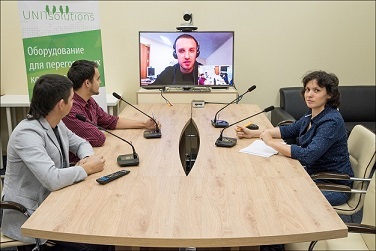 Video conferencing has ceased to be an exotic concept and is increasingly penetrating our everyday work environment. She went beyond the meeting rooms and became available in the workplace of employees and mobile devices. Such widespread videoconferencing is facilitated by an ever-increasing transition from purely hardware solutions (such as Polycom, Cisco, LifeSize) to software and hardware-software solutions. There are several reasons for this transition, but the main ones are as follows:
Video conferencing has ceased to be an exotic concept and is increasingly penetrating our everyday work environment. She went beyond the meeting rooms and became available in the workplace of employees and mobile devices. Such widespread videoconferencing is facilitated by an ever-increasing transition from purely hardware solutions (such as Polycom, Cisco, LifeSize) to software and hardware-software solutions. There are several reasons for this transition, but the main ones are as follows:- Software solutions for video conferencing are more affordable without losing functionality.
- Software solutions VCs provide greater flexibility in equipping workplaces and meeting rooms, in contrast to the standardized composition of hardware terminals.
This article, on the example of a specific meeting room, describes how it is possible to equip a room with video conferencing facilities simply and relatively inexpensively.
The concept of a standard meeting room
The meeting room is now in almost any company. This is the place where meetings between employees, meetings with clients, discussion of projects are held. Recently, meeting rooms are also used for video conferencing with remote participants. The equipment of such meeting rooms allows participants to hear and see each other at a distance in real time, share content (presentations, slides, videos).
As a rule, meeting rooms have a metric of 25-30 square meters and a capacity of 8-10 people. These rooms are medium-sized meeting rooms.
')
Modular approach to equipping meeting rooms
Before turning to specific examples of equipment, you should talk about the modular approach.
Today, equipping a meeting room with video conferencing equipment has ceased to be a highly specialized task. Previously, the hardware terminal with a predetermined composition of components was almost the only option for VKS equipment. Now the personal computer with the software client of the video conferencing center becomes the central hub, for example: Skype, Polycom Realpresence Desktop or TrueConf.
Both of these options solve the problem - they provide participants with video calls, but they have different approaches:
- The option based on a specialized hardware terminal involves placing typed equipment in the room — a video camera with the parameters offered by the manufacturer, a microphone, also a specific model, a central computing unit with certain functional capabilities, and so on. Connectors for connecting equipment to the central unit are often proprietary. This complicates the replacement of components. For example, Polycom produces video cameras with a non-standard HDCI connector, which without “dancing with a tambourine” is difficult to connect to anything other than the hardware terminals of the same company. This imposes certain difficulties when connecting cameras through a video switchboard to build more complex video conferencing systems. The flexibility of upgrading and scaling in such hardware solutions is not much, and its high cost makes it not accessible to everyone.
- The option based on a personal computer, equipped in the simplest case with a video camera and microphone, gives more flexibility in choosing equipment, as the connection interfaces (USB, HDMI, 3.5 mm analog connector) are standardized and present in any modern personal computer.
The second equipment option embodies the modular approach to equipping a meeting room, which involves the separation of all equipment into several subsystems, the composition of each of which can be changed without loss of overall functionality. Video and audio signals of each of these subsystems are connected to the client terminal on the basis of a personal computer.
- Subsystem technology television. In essence, this is a video camera system. For large conference rooms, several video cameras are needed to capture all participants in the video. In the case of an average meeting room, a single video camera with a suitable viewing angle, swivel lens and optical zoom (PTZ) is sufficient.
- Subsystem display information. This may be a projector or screen, but recently LCD panels are increasingly being used because of their availability and convenience - no need, as is the case with a projector, to specifically dim the room or periodically change light bulbs. When choosing the size of the TV, you should be guided by the following rule: the distance from the TV to the nearest participants should be at least one diagonal of the TV, and to the farthest participant - no more than four diagonals.
It is clear that for a long room, based on this recommendation, you will need a large diagonal TV. In some cases, the best options for the display subsystem become a video wall or duplicate screens.
Video wall - a set of display devices (projection video cubes, plasma or LCD displays), which are combined with each other and form a single screen that allows you to play large volumes of information from different sources in a multi-window mode. The issue of video walls is very voluminous and is beyond the scope of this article. But the main parameters that you should pay attention to when choosing a video wall are: its size in inches, the width of the seam between the panels (usually 5.5 mm), the mode of operation, video sources and the functionality that the video wall controller must implement.
When collaborating with documents, the use of auxiliary panels that duplicate an image from the main screen becomes much more useful than one big screen. In this case, you must use a video splitter. - Subsystem sound capture. The wide-directional frog microphones, which are part of the hardware terminals, are replaced by speakerphones - devices that combine an array of microphones and a speaker. They connect to the computer via USB and provide effective echo and noise reduction, as well as a large radius of sound capture. In addition, speakerphones have the ability to cascade into a circuit to expand the sound capture zone.
- Room Subsystem There are a lot of options - from speakerphones and loudspeakers built into the LCD TV and ending with ceiling loudspeakers that evenly sound the whole room.
Description of the used meeting room
This article will explain how to equip video conferencing equipment with a specific medium-sized meeting room. The room has an area of 42 square meters (6x7m) and can accommodate up to 10 people with one table stretched along the screen axis. This is the most typical case.
A 49-inch LCD TV with 10W built-in speakers is used as a display information subsystem. Close to the TV is a rectangular meeting table for 8 people. Ceilings have a height of 3.5 meters, the walls are made of drywall. Carpet is used as a floor covering.
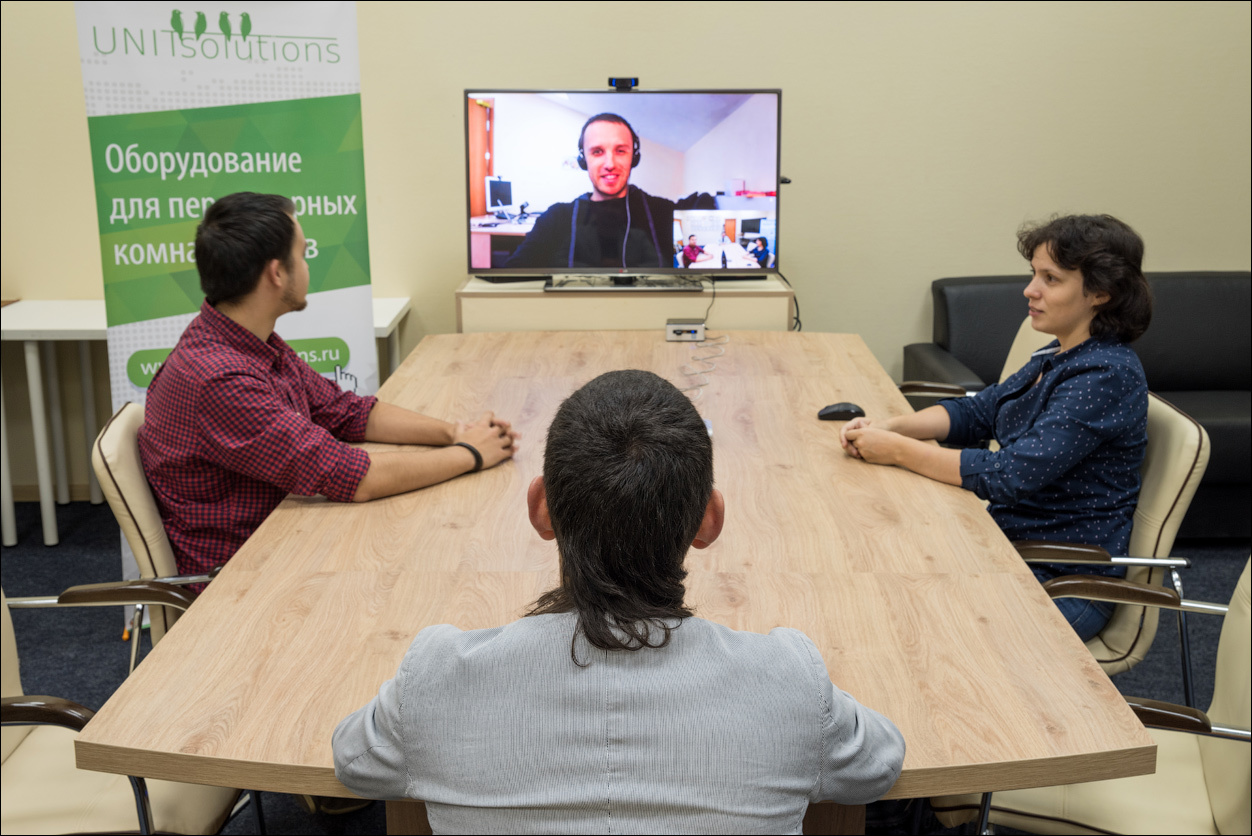
Options for meeting room facilities
As mentioned earlier, a modular approach to equipping meeting rooms, gives more flexibility and freedom in choosing equipment, depending on the tasks and allocated budget.
This article will demonstrate several options for equipment on the example of specific models of equipment.
For video conferencing, the software server of the domestic developer company TrueConf will be used. In the meeting room is a mini personal computer based on Intel NUC with an Intel i3 processor and 4GB of RAM. It has the TrueConf Client software client installed. You can use other clients for video calling: free Skype, Google Hangouts and paid - GoToMeeting, Cisco Webex, Polycom RealPresense, etc. The equipment described in our article will work with any of these solutions. This is the advantage of the modular approach!
So, option 1. For a group of 3-4 participants
For the budget equipment of a small meeting room or workplace for a manager, we recommend using the following set of equipment:
- Webcam Logitech HD Pro Webcam C920 , providing the transfer of images with a resolution of 1080p30 and connected to a computer via USB 2.0. The webcam can be fixed on the TV.
- Phoenix Audio Duet PCS speakerphone , providing a sound capture radius of 1-1.5 meters and connected to a computer via USB interface.
- There is an alternative model of this speakerphone, Phoenix Audio Duet EXE , which can be used as a headset for an office phone with an RJ11 connector or for a smartphone with a 3.5mm connector.
The webcam and speakerphone are defined in the operating system as video and audio devices and are ready to work in a minute. Here is what this kit looks like in our meeting room:

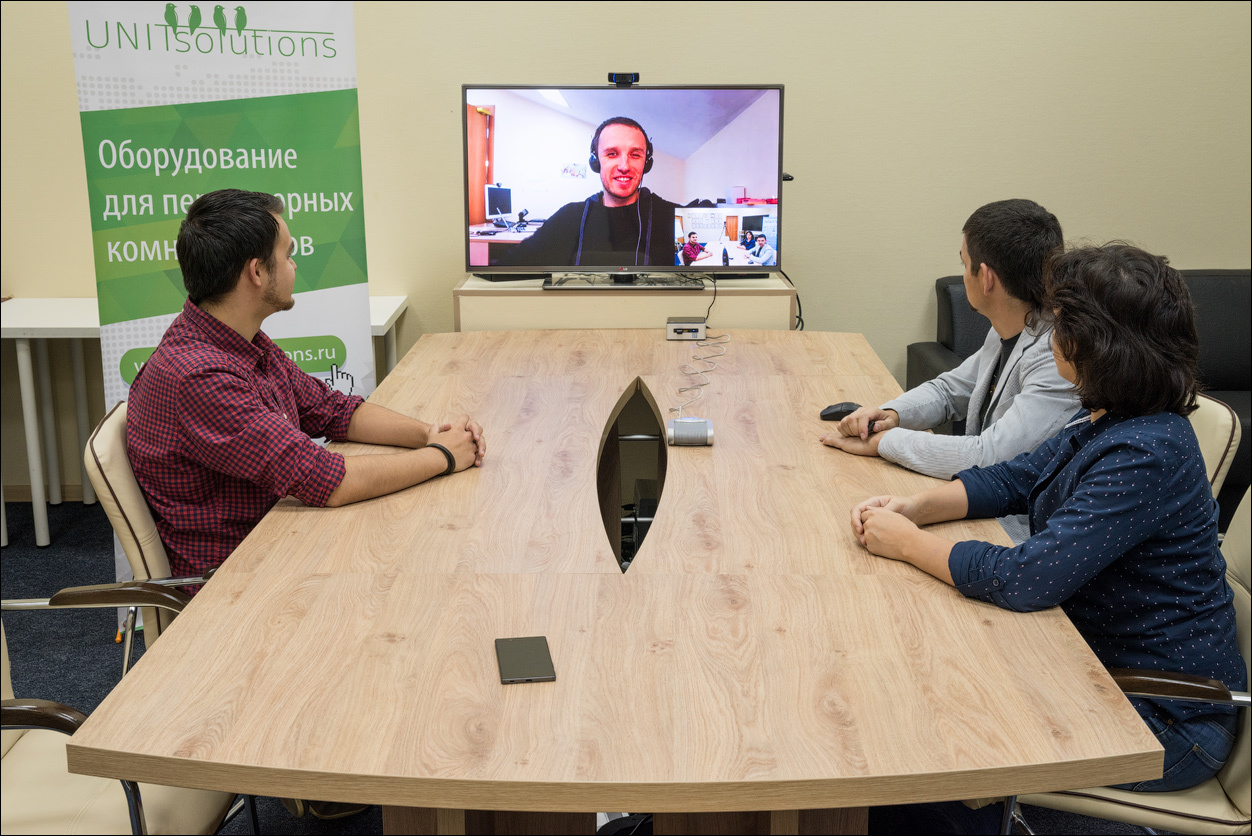
As can be seen from the description of the equipment, this kit is suitable for equipping small working groups of 3-4 participants or personal workplaces of employees. Its advantage is an excellent price / quality ratio. For larger working groups, such equipment, of course, will not work. Therefore, we proceed to the next option.
Option 2. For a group of 6-8 people
In the case of an increase in the number of people at the conference table, there is a problem of replacing the webcam with a PTZ PTZ camera and replacing the speakerphone with an “older” model with a larger sound capture radius (a modular approach in action!).
Before giving examples of specific equipment, I would like to give a couple of recommendations regarding the placement of a video camera in a meeting room. The key parameters of any video camera are optical zoom and viewing angle. Optical zoom determines the magnification of the image. The viewing angle determines the size of the captured space of the room. For example, the standard viewing angle of 72 degrees allows the closest accommodation of participants to it at a distance not closer than 1.5 meters. At the same time, a video camera with a viewing angle of 105 degrees captures people sitting close enough to the camera (at a distance of one meter).
- To ensure that all participants are in the field of view of the camera, they should be no closer than the viewing angle of the camera allows;
- It is recommended to install the camera in the height range of 1.2-1.8 m from the floor;
In the first variant, it was noticeable that the angle of view of the webcam of 78 degrees did not ensure the capture of closely-seated people - they “fell out” of the camera’s field of view, and the camera itself does not have any digital or even optical zoom.
The CleverMic Wide swivel FullHD video camera has a wide viewing angle of 105 degrees and is designed for use in small meeting rooms. In addition, it has 3x optical zoom and 3x digital zoom. The camera is controlled from the remote control and can switch between previously saved positions (presets). Thus, at the touch of a button on the control panel, you can, for example, give a large view of the meeting leader, individual participants or a flipchart.
For a group of 6-8 people, it is recommended to use a Phoenix Audio Spider (MT503) speakerphone with a guaranteed sound pickup radius of 2.5 meters. The speakerphone has four built-in microphones and an average speaker power (5 W), so that it can be used to sound the room. On the speakerphone itself there is a convenient touch control panel with buttons for turning off microphones and adjusting the volume of speakers and microphone sensitivity. Echo and noise cancellation technologies, direction finding algorithm (determining the sound source and the direction of microphones to it) and other pleasant technical capabilities ensure comfortable communication with remote participants without the need to raise your voice or get closer to a speakerphone.
The video camera and speakerphone are Plug-n-Play devices, are connected to the terminal via USB interfaces and are defined in the operating system as video and audio devices, all necessary drivers are installed automatically. Therefore, commissioning of the equipment takes no more than five minutes. Here is what this kit looks like in the meeting room:
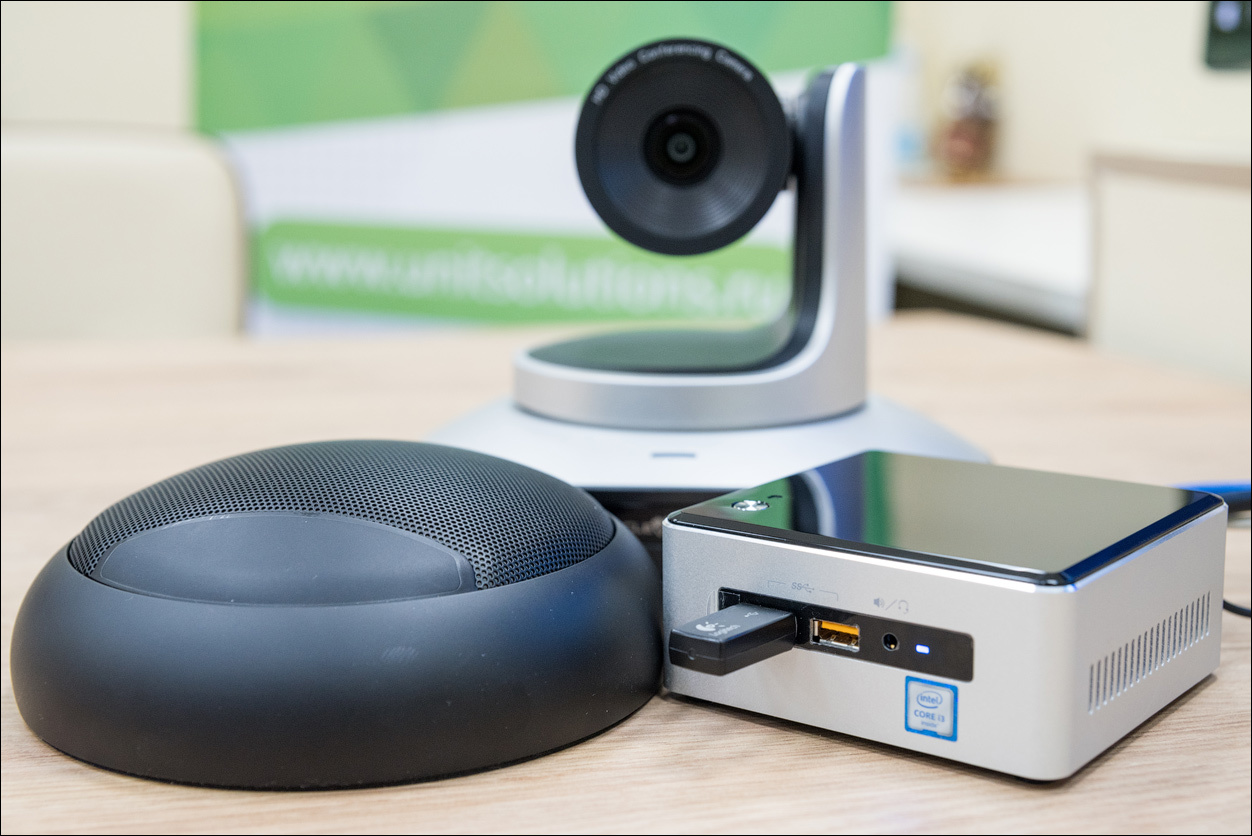
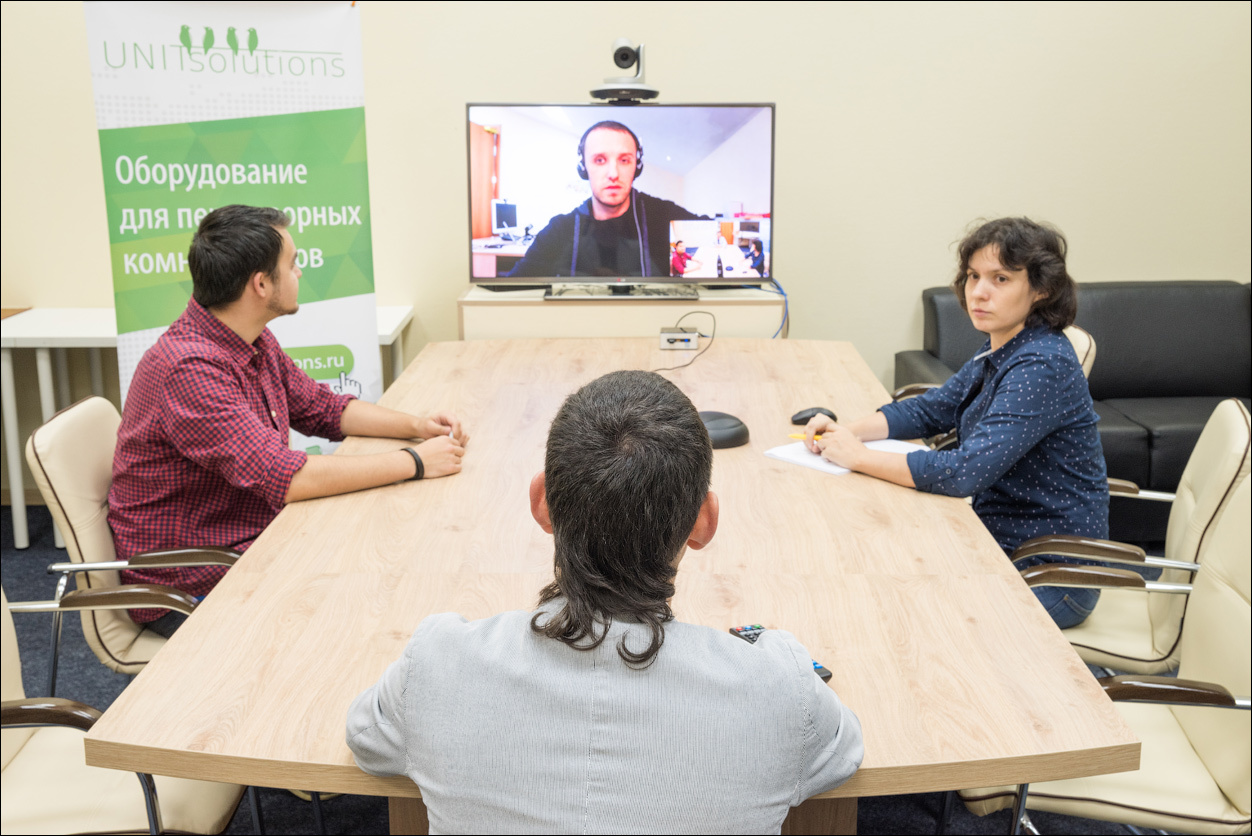

Option 3. For a group of more than 8 people
What if the number of people in the room is more than eight? In this case, you need a video camera with a large optical zoom, and to capture the sound you need more than one speakerphone.
The CleverMic Uno video camera has a 12x optical zoom, which allows you to take close-ups of any meeting participant, even the most distant, and also transfer the image from a flipchart or, for example, the process of signing documents. By quickly switching the camcorder position from the control panel, the meeting process becomes more efficient and interactive.
To expand the audio capture zone to the Phoenix Audio Spider (MT503) speakerphone over twisted pair, another Phoenix speakerphone of the same or another model from this line is connected. The number of speakerphones connected in this way in a chain can reach 15, and it is not necessary to lay them on the table - you can also fix it on the ceiling. It is important to understand that the speakerphones are very “smart”, they work synchronously and coordinate their actions, and this is precisely the “trick” of Phoenix Audio products.
Often in the meeting room there is an IP phone. Phoenix Audio Spider (MT505) conference phone is not only a speakerphone, but also an IP phone. In the photo below, the MT503 speakerphone and the MT505 conference phone are used to capture the sound. In such a bundle, an audio telephony subscriber can be connected to a video call at any time through the built-in USB mixer and SIP interfaces in the conference phone itself.


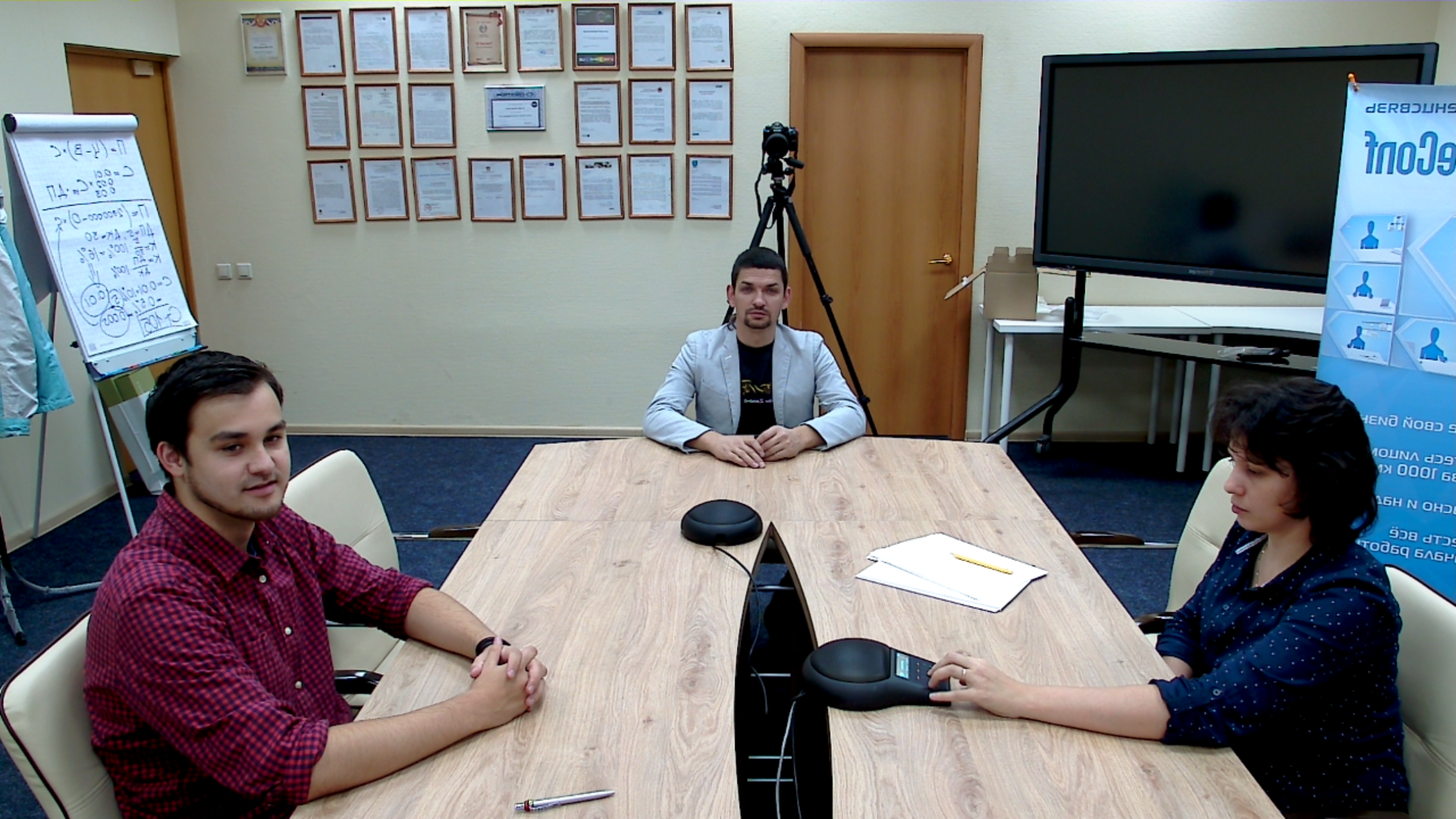
Option 4. With microphone array
Another option for equipping a meeting room differs from the previous ones in that the so-called Phoenix Condor (MT600) microphone array is used as a sound capture subsystem.
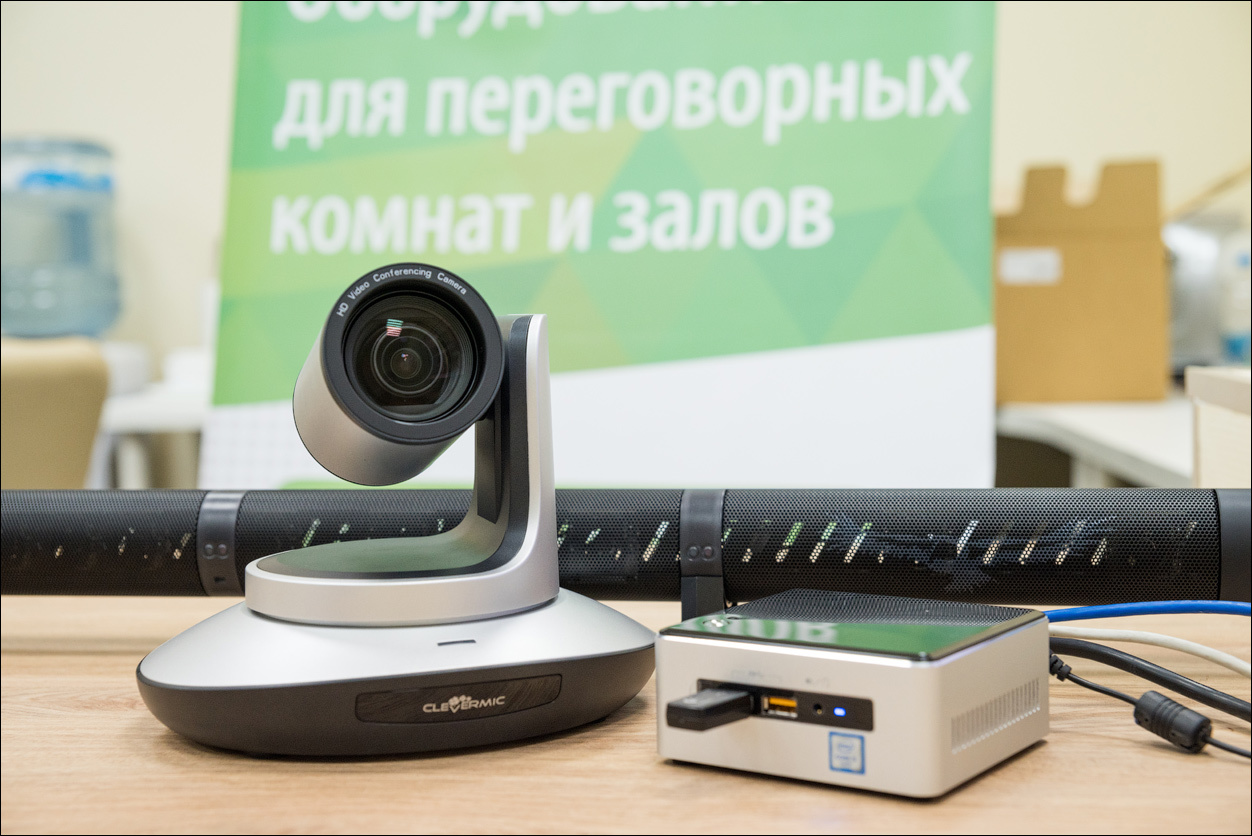
The microphone array is a 122-centimeter tube with 15 built-in microphones, providing a confident capture of sound to a depth of 10 meters. The built-in mechanisms for echo and noise cancellation and the simultaneous capture of several speakers makes the process of communication easy and enjoyable. The microphone array is connected to a personal computer via USB and can be located either on the conference table or mounted on the wall under the TV, freeing the conference table from the equipment. In addition, the Condor microphone array has the ability to connect to SIP telephony. For the sound of the room can be used either the TV speakers or speakers connected to the Phoenix Condor.
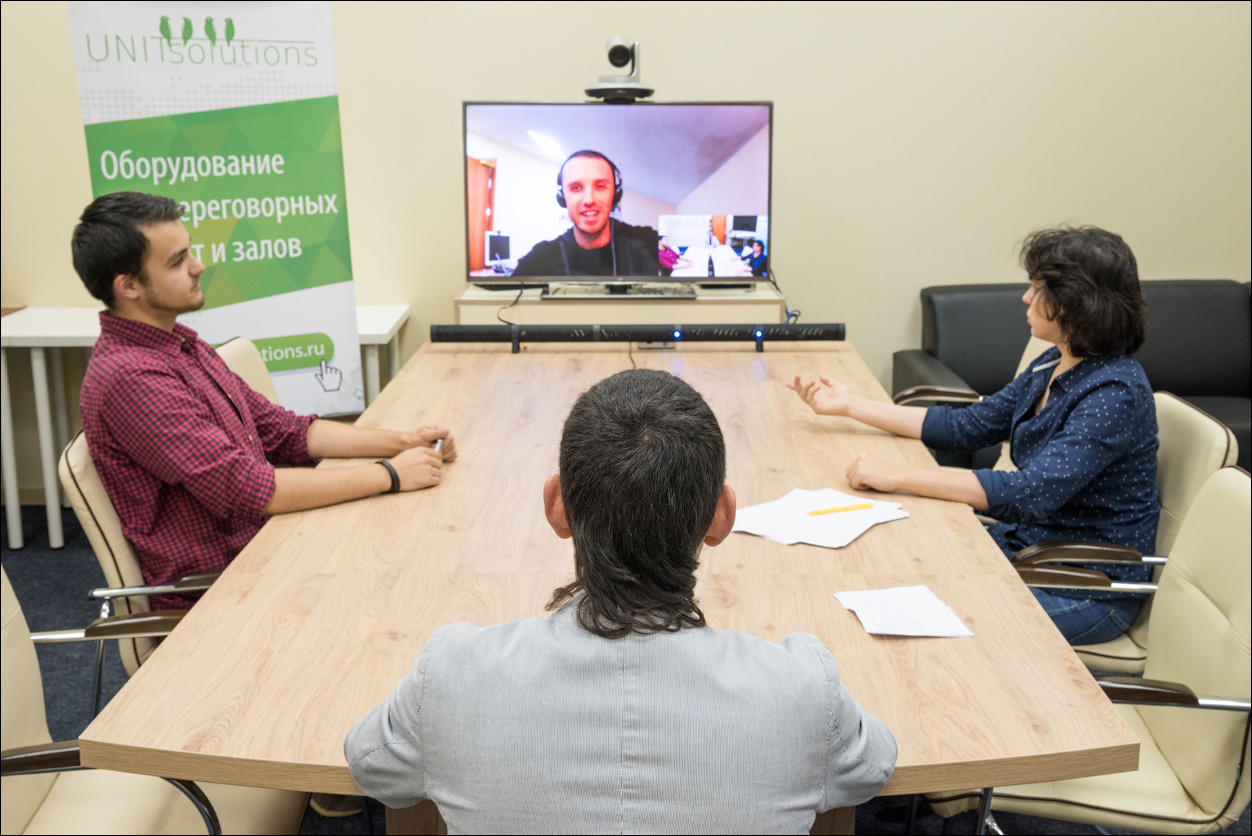
Option 5. For a group of more than 10 people
For capturing sound in meeting rooms for 10 or more people, it is recommended to use the congress system. A congress system is a set of audio equipment that provides a specific set of conference functionality, consisting of a central unit and several gooseneck microphone consoles. Narrowly focused microphone consoles provide excellent sound capture from each participant. Up to six consoles can be active at one time.
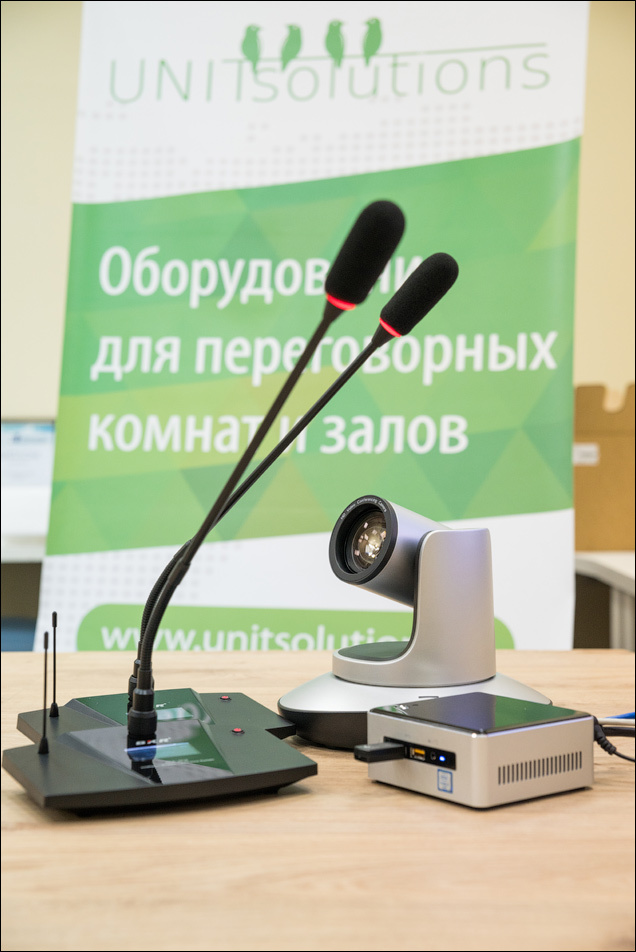
Congress systems are wired and wireless. In the case of wired systems, the microphone consoles are connected in series with each other by a cable in a chain. Wireless systems give more freedom in placing microphone consoles on conference tables. The sound signal from the microphone consoles is transmitted through the central unit either to a personal computer directly (to the line-in interface), or to an audio mixer or a hardware video conferencing terminal.
As a wired congress system in the meeting room was installed Samcen 6100MA with microphones S6050D .
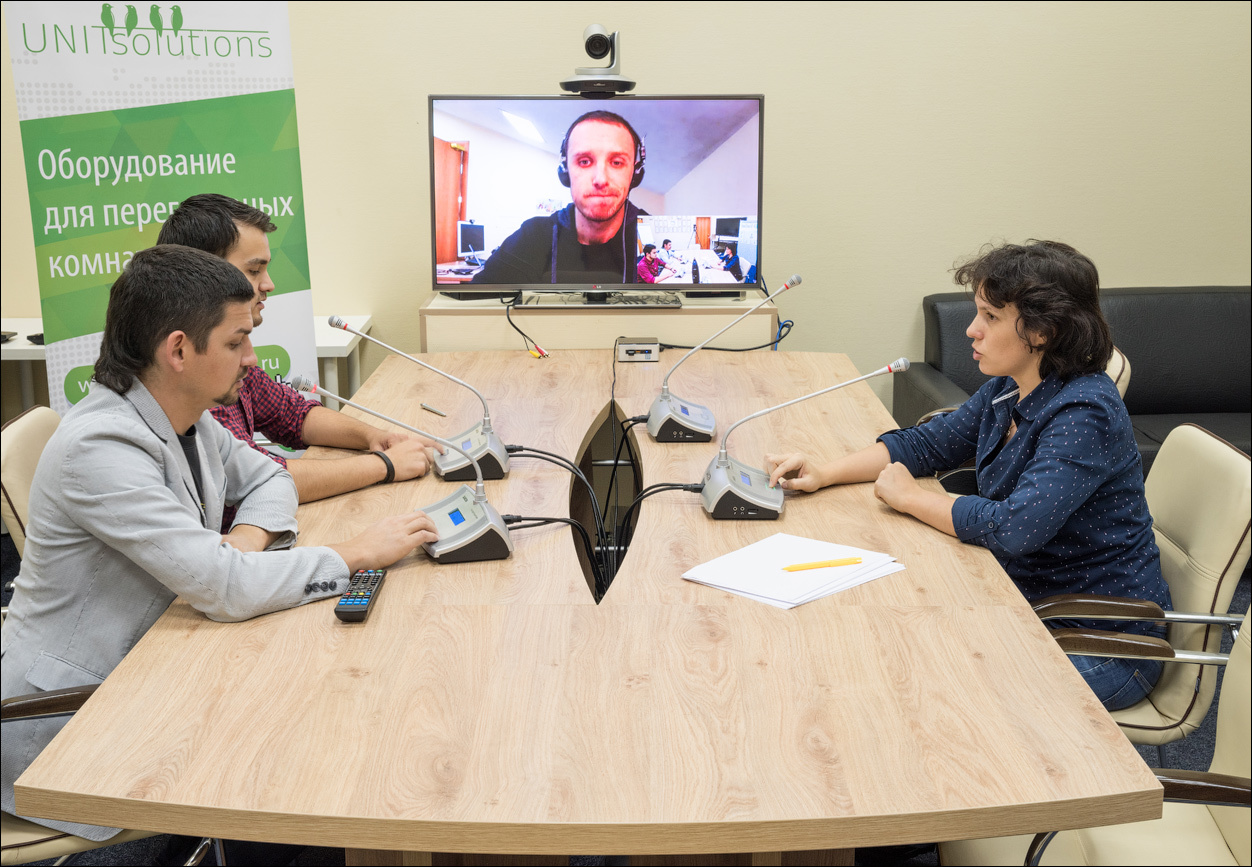
As a wireless - BKR WCS-20M system with BKR WCS-201D microphones .
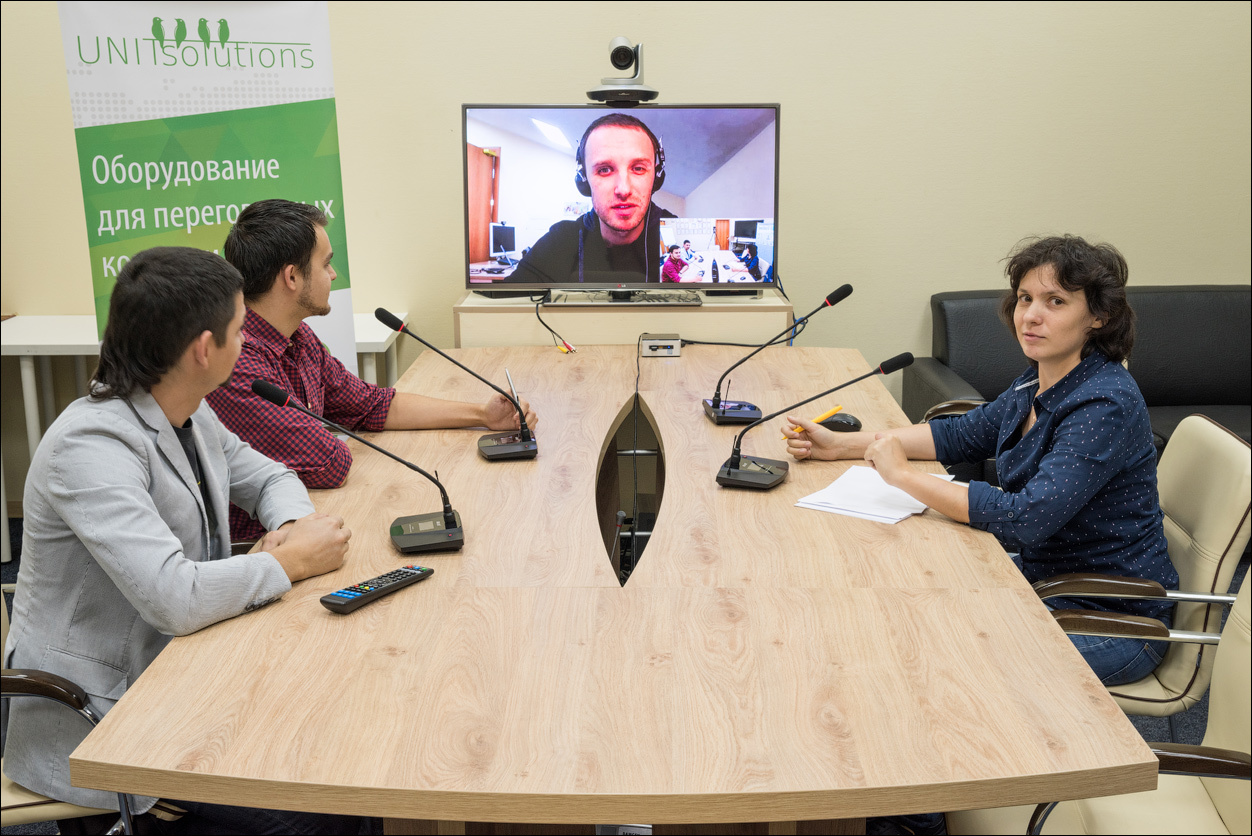
The pleasant moment of these congress systems is their function of automatically pointing a PTZ video camera onto an active microphone remote without the need for an additional control system (Crestron, AMX, etc.).
findings
Video conferencing is a dynamically developing area of information technology that has become part of our lives. Now to equip meeting rooms and workstations of employees do not require deep core knowledge due to the wide distribution of video conferencing software solutions. In this article, using the example of a real meeting room, several variants of its equipment were demonstrated.
Of course, the article does not cover the whole variety of arising problems. In the next article, we will use a concrete example to show how to set up automatic camera pointing at a speaker. You, in turn, can write in the comments questions you are interested in and suggest ideas for future articles.
Source: https://habr.com/ru/post/398025/
All Articles